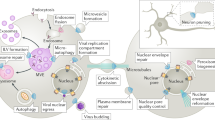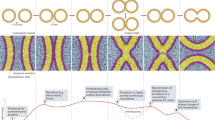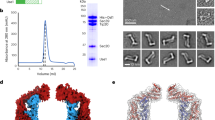Abstract
At least two distinct ATPases, NSF and p97, are known to be involved in the heterotypic fusion of transport vesicles with their target membranes and the homotypic fusion of membrane compartments1. The NSF-mediated fusion pathway is the best characterized, many of the components having been identified and their functions analysed2,3,4,5,6,7. In contrast, none of the accessory proteins for the p97-mediated fusion pathway has been identified8,9,10. Now we have identified the first such component, a protein of relative molecular mass 47,000 (p47), which forms a tight, stoichiometric complex with cytosolic p97 (one trimer of p47 per hexamer of p97). It is essential for the p97-mediated regrowth of Golgi cisternae from mitotic Golgi fragments, a process restricted to animal cells11. As a homologue of p47 exists in budding yeast, this indicates that it might also be involved in other membrane fusion reactions catalysed by p97, such as karyogamy10.
This is a preview of subscription content, access via your institution
Access options
Subscribe to this journal
Receive 51 print issues and online access
$199.00 per year
only $3.90 per issue
Buy this article
- Purchase on Springer Link
- Instant access to full article PDF
Prices may be subject to local taxes which are calculated during checkout





Similar content being viewed by others
References
Rothman, J. E. & Warren, G. Implications of the SNARE hypothesis for intracellular membrane topology and dynamics. Curr. Biol. 4, 220–233 (1994).
Rothman, J. E. & Wieland, F. T. Protein sorting by transport vesicles. Science 272, 227–234 (1996).
Pryer, N. K., Wuestehube, L. J. & Schekman, R. Vesicle-mediated protein sorting. Annu. Rev. Biochem. 61, 471–516 (1992).
Ferro-Novick, S. & Jahn, R. Vesicle fusion from yeast to man. Nature 370, 191–193 (1994).
Nuoffer, C. & Balch, W. E. GTPases—multifunctional molecular switches regulating vesicular traffic. Annu. Rev. Biochem. 63, 949–990 (1994).
Schiavo, G., Rossetto, O. & Montecucco, C. Clostridial neurotoxins as tools to investigate the molecular events of neurotransmitter release. Sem. Cell Biol. 5, 221–229 (1994).
Pfeffer, S. R. Transport vesicle docking: SNAREs and associates. Annu. Rev. Cell Dev. Biol. 12, 441–461 (1996).
Rabouille, C., Levine, T. P., Peters, J. M. & Warren, G. An NSF-like ATPase, p97, and NSF mediate cisternal regrowth from mitotic Golgi fragment. Cell 82, 905–914 (1995).
Acharya, U. et al. The formation of Golgi stacks from vesiculated Golgi membranes requires two distinct fusion events. Cell 82, 895–904 (1995).
Latterich, M., Frohlich, K. U. & Schekman, R. Membrane fusion and the cell cycle: Cdc48p participates in the fusion of ER membranes. Cell 82, 885–893 (1995).
Warren, G. Membrane partitioning during cell division. Annu. Rev. Biochem. 62, 323–348 (1993).
Peters, J.-M. et al. Ubiquitous soluble Mg2+-ATPase complex: A structural study. J. Mol. Biol. 223, 557–571 (1992).
Peters, J. M. & Walsh, M. J. & Franke, W. W. An abundant and ubiquitous homo-oligomeric ring-shaped ATPase particle related to the putative vesicle fusion proteins, Sec18p and NSF. EMBO J. 9, 1757–1767 (1990).
Confalonieri, F., Marsault, J. & Duguet, M. SAV, an archaebacterial gene with extensive homology to a family of highly conserved eukaryotic ATPases. J. Mol. Biol. 235, 396–401 (1994).
Scherens, B., el Bakkoury, M., Vierendeels, F., Dubois, E. & Messenguy, F. Sequencing and functional analysis of a 32,560 bp segment on the left arm of yeast chromosome II. Identification of 26 open reading frames, including the KIP1 and SEC17 genes. Yeast 9, 1355–1371 (1993).
Zhang, S., Guha, S. & Volkert, F. C. The Saccharomyces SHP1 gene, which encodes a regulator of phosphoprotein phosphatase 1 with differential effects on glycogen metabolism, meiotic differentiation, and mitotic cell cycle progression. Mol. Cell. Biol. 15, 2037–2050 (1995).
Tu, J. L., Song, W. J. & Carlson, M. Protein phosphatase type I interacts with proteins required for meiosis and other cellular processes in Saccharomyces cerevisiae. Mol. Cell. Biol. 16, 4199–4206 (1996).
Sutton, A., Lin, F. & Arndt, K. T. The SIT4 protein phosphatase is required in late G1 for progression into S phase. Cold Spring Harb. Symp. Quant. Biol. 56, 75–81 (1991).
Frohlich, K.-U. et al. Yeast cell cycle protein CDC48p shows full-length homology to the mammalian protein VCP and is a member of a protein family involved in secretion, peroxisome formation, and gene expression. J. Cell Biol. 114, 443–453 (1991).
Rabouille, C., Misteli, T., Watson, R. & Warren, G. Reassembly of Golgi stacks from mitotic Golgi fragments in a cell-free system. J. Cell Biol. 129, 605–618 (1995).
Sutton, C. W. et al. Identification of myocardial proteins from two-dimensional gels by peptide mass fingerprinting. Electrophoresis 16, 308–316 (1995).
Coull, J. M., Pappin, D. J., Mark, J., Aebersold, R. & Koster, H. Functionalized membrane supports for covalent protein microsequence analysis. Analyt. Biochem. 194, 110–120 (1991).
Hunt, D. F., Yates, J. R., Shabanowitz, J., Winston, S. & Hauer, C. R. Protein sequencing by tandem mass spectrometry. Proc. Natl Acad. Sci. USA 83, 6233–6237 (1986).
Saxton, W. O. Semper: distortion compensation, selective averaging, 3-D reconstruction, and transfer function correction in a highly programmable system. J. Struct. Biol. 116, 230–236 (1996).
Acknowledgements
We thank T. Chappell, F. Barr, B. Svejstrup, B. Sönnichsen, M. Lowe, C. Fernandez, D. Shima, J. Shorter, N. Hui and A. Coffer for helpful comments and for reagents; G. Banting for the rat liver cDNA library; J.-M. Peters for monoclonal anti-p97 antibodies; G. Clark and A. Davies for DNA sequencing; and D. Rahman for protein sequencing. Special thanks go to N. Nakamura for advice.
Author information
Authors and Affiliations
Corresponding author
Rights and permissions
About this article
Cite this article
Kondo, H., Rabouille, C., Newman, R. et al. p47 is a cofactor for p97-mediated membrane fusion. Nature 388, 75–78 (1997). https://doi.org/10.1038/40411
Received:
Accepted:
Issue Date:
DOI: https://doi.org/10.1038/40411
This article is cited by
-
In silico prediction, characterization, docking studies and molecular dynamics simulation of human p97 in complex with p37 cofactor
BMC Molecular and Cell Biology (2022)
-
The determination of the relationship between p97/VCP, small VCP-interacting protein, two ERAD proteins and steroidogenesis in Leydig cell lines
Molecular Biology Reports (2022)
-
Ring finger protein 213 assembles into a sensor for ISGylated proteins with antimicrobial activity
Nature Communications (2021)
-
Degradation of p47 by autophagy contributes to CADM1 overexpression in ATLL cells through the activation of NF-κB
Scientific Reports (2019)
-
The involvement of endoplasmic reticulum formation and protein synthesis efficiency in VCP- and ATL1-related neurological disorders
Journal of Biomedical Science (2018)
Comments
By submitting a comment you agree to abide by our Terms and Community Guidelines. If you find something abusive or that does not comply with our terms or guidelines please flag it as inappropriate.



